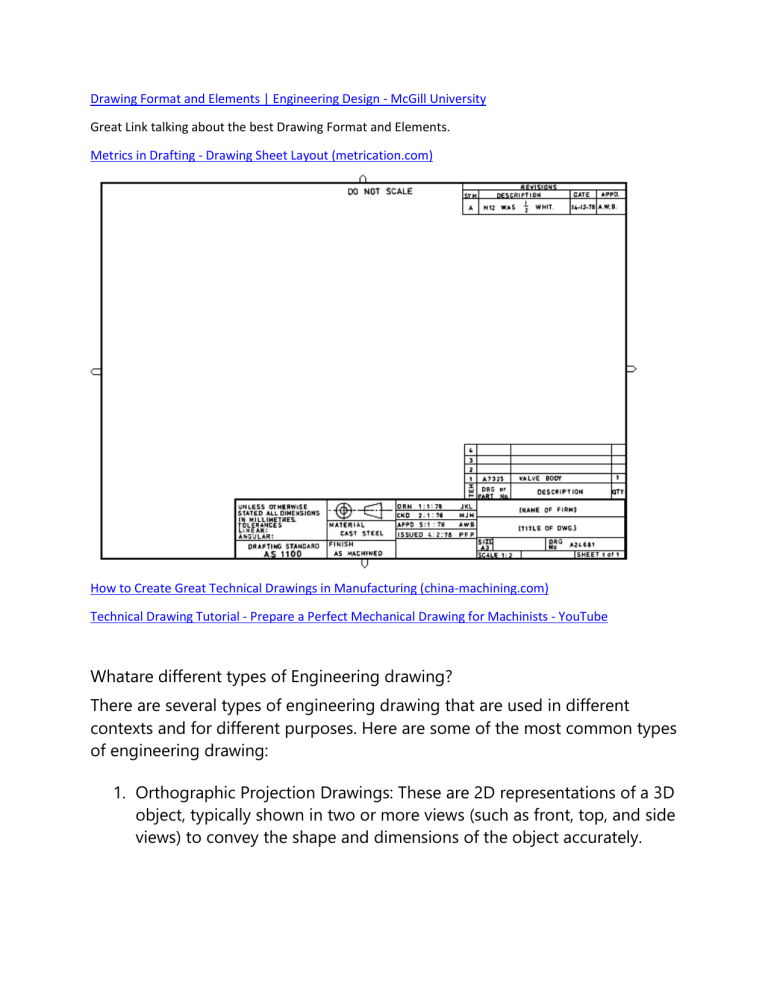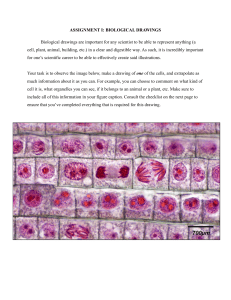
Drawing Format and Elements | Engineering Design - McGill University Great Link talking about the best Drawing Format and Elements. Metrics in Drafting - Drawing Sheet Layout (metrication.com) How to Create Great Technical Drawings in Manufacturing (china-machining.com) Technical Drawing Tutorial - Prepare a Perfect Mechanical Drawing for Machinists - YouTube Whatare different types of Engineering drawing? There are several types of engineering drawing that are used in different contexts and for different purposes. Here are some of the most common types of engineering drawing: 1. Orthographic Projection Drawings: These are 2D representations of a 3D object, typically shown in two or more views (such as front, top, and side views) to convey the shape and dimensions of the object accurately. 2. Isometric Drawings: These are 3D representations of an object that show all three dimensions (height, width, and depth) at once, typically at a 120-degree angle. 3. Exploded Views: These drawings show an object that has been disassembled into its component parts, with each part separated and labeled for clarity. 4. Assembly Drawings: These are used to show how parts of a product or machine fit together, with detailed instructions on how to assemble them correctly. 5. Piping and Instrumentation Diagrams (P&ID): These are used to show the piping and instrumentation systems used in industrial settings, including details of pipes, valves, pumps, and other equipment. 6. Wiring Diagrams: These show the electrical connections and components used in electrical systems, such as circuits or wiring layouts. 7. Structural Drawings: These are used to show the structural components of a building or other structure, including beams, columns, and foundations. 8. Patent Drawings: These are used to illustrate an invention or design for the purpose of obtaining a patent. Each type of engineering drawing serves a specific purpose and requires different techniques and tools to create. Understanding the different types of engineering drawings is important for communicating technical information accurately and effectively. Regenerate response Engineering Drawings (cam.ac.uk) (Engineering Drawing Types) Engineering drawing, also known as technical drawing, is a form of technical documentation that provides detailed information about a component, system, or structure. There are several types of engineering drawings, including: 1. Architectural drawings: These drawings provide detailed information about the design and layout of buildings, including floor plans, elevations, and sections. 2. Structural drawings: These drawings provide detailed information about the structural design of a building or other structure, including foundation plans, framing plans, and details of structural elements. 3. Mechanical drawings: These drawings provide detailed information about mechanical systems and components, such as HVAC systems, plumbing systems, and machinery. 4. Electrical drawings: These drawings provide detailed information about electrical systems and components, such as wiring diagrams, electrical layouts, and details of electrical equipment. 5. Piping and instrumentation diagrams (P&IDs): These drawings provide detailed information about the piping systems and instrumentation used in industrial plants and facilities. 6. Flow diagrams: these diagrams are used to represent the flow of materials, fluids, or energy in a process or system. 7. Assembly drawings: These drawings provide detailed information about how various components are assembled to form a larger system or product. 8. Detail drawings: These drawings provide detailed information about specific components or parts of a system or structure, including dimensions, tolerances, and material specifications. 9. Isometric drawings: These drawings provide a 3D representation of an object, it gives the viewer a better understanding of how the object looks like and how it's constructed. Overall, the type of engineering drawing used will depend on the specific project and the information that needs to be conveyed.


